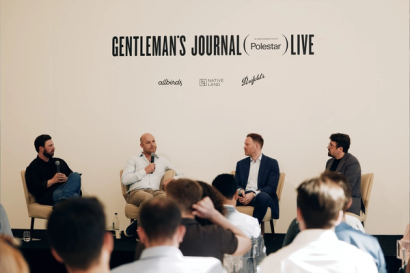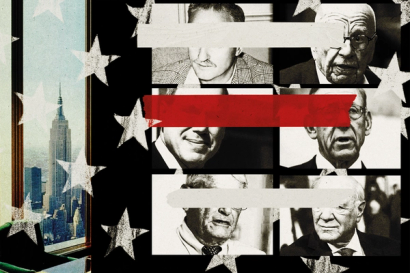
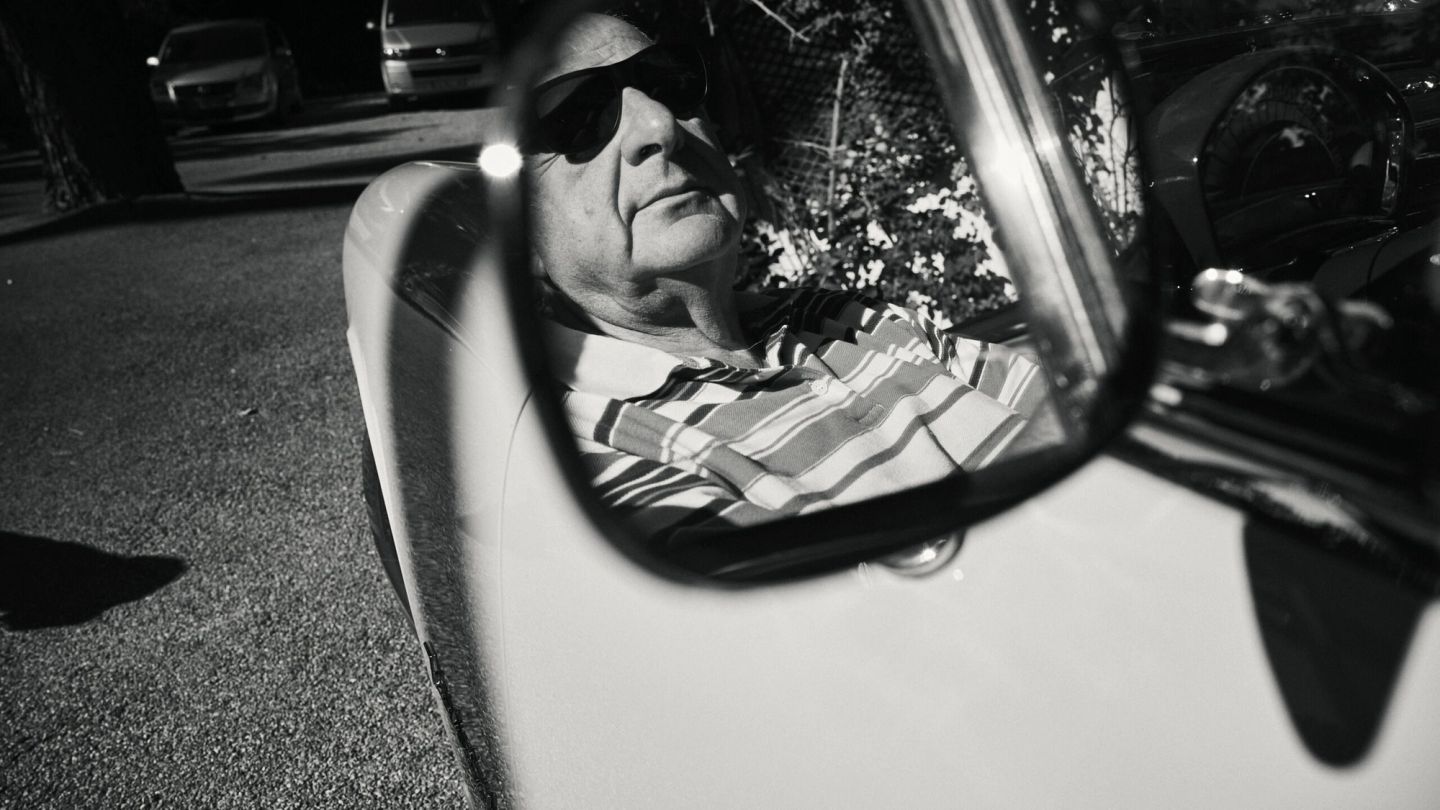
“My friends call me Johnny…” At home with Jean Pigozzi — tech investor, art collector, and the world’s best connected man
His mentors included Gianni Agnelli and Jimmy Goldsmith; Elon Musk, Mick Jagger and Michael Douglas are among his best friends; and anyone who's anyone has swum in his pool. As Jean Pigozzi turns 70, we step inside a charmed life.
Jean Pigozzi has two swimming pools: one for ideas, and the other for friends. The first is long and thin and lined with black stone, and at the end of it there’s a little yellow exercise book, encased in rubber and bound to a special pen, which is engineered to make notes in aquatic conditions. (Pigozzi does his best thinking mid-dunk, he says — but he’s got a copy in the shower too, just in case).
The second is shaped like a kidney bean, and is beamed directly from the denouement party scene of a 1970s Beverly Hills romp. It has its own coffee table book and apparently its own gravitational pull — a quick flick through the former reveals Naomi Campbell alongside Woody Allen; Michael Douglas next to Jack Dorsey; Cindy Crawford and Charles Saatchi splashing among the oversized inflatables. The awnings around the pool’s edge, meanwhile, are coloured bright orange (as opposed to the ubiquitous Riviera blue), because Pigozzi heard from designer Ettore Sosstass who got it from a fishmonger in Sicily who got it, presumably, from a particularly vain lobster, that all seafood looks better and fresher under a sunset orange glow — and so all people must do, too. (“There’s no fish here,” he smiles. “But some of the people who come over look like fish…”)
Each pool sits in the grounds of Pigozzi’s Antibes home, Villa Dorane — a sizable tract of green and fragrant land, lined with tall cypress trees and flecked with seasalt, that lies somewhere between the Heineken dynasty to the left and Roman Abramovich to the right. And each tells you a little bit about the man who likes to swim in it. Various bios list Jean Pigozzi as a venture capitalist, a photographer, a conservationist, a philanthropist, and an industrial heir. But it would be a truer to say he is simply a collector: of ideas, of pictures, of companies; of moments, of distractions, of curios; of lessons, of anecdotes — and of people.
That last one is the reason, ostensibly, that we’re here today. Pigozzi has just released a book called The 213 Most Important Men in My Life, and the back cover alone is not so much a name drop as a carpet bomb. Tom Hanks, Mick Jagger, Nelson Mandela, John McEnroe, Rupert Murdoch, Jerry Seinfeld, Steven Spielberg — all within a square inch of back cover real estate. On anyone else, an all caps list of the great and good of the Twentieth Century would look a little icky. But everyone knows that everyone knows Jean Pigozzi, and to pretend otherwise would just be dull, or British. In 2014, The Esquire Television Network released a series called ‘My Friends Call Me Johnny’ — a globe-trotting chat show predicated on Pigozzi’s ludicrous network, which took in Michael Douglas, Martha Stewart and Calvin Klein in its first few episodes. A 2010 Vanity Fair profile has mega-banker Ronald Perelman gawping at Pigozzi’s personal matrix: “If somebody offers him a deal to make chocolate pudding in Nigeria, he can pick up the phone and in two calls get to the minister of food and agriculture in Nigeria and find out if there’s a market for it.” Forget ‘Six Degrees of Kevin Bacon’, the parlour game that insists everyone in Hollywood is connected by the ubiquitous star. Among the people that matter, it’s One Degree of Jean Pigozzi. And to Jean Pigozzi, they all matter.
"The minute you stop being curious, you may as well check out..."
I ask him what unites all the figures in the new book, beyond the fact, of course, that they all know Jean Pigozzi. The opening letter describes them collectively as “men who changed my way of thinking. Men who taught me things, opened my eyes, made me laugh, and helped me.” (It also contains a litany, more telling perhaps, of the things they most definitely are not: “Pompous, pretentious intellectuals, fake intellectuals, politicians, bad listeners, drinkers, super druggies, badly behaved, short tempered, and self obsessed…”)
“I like people who are sincere and curious,” Pigozzi explains, propped up on a baby blue towelling sunbed in the late september heat. “Because the minute you stop being curious, you may as well check out. A lot of people have a job, and a wife, and two and a half children, and a labrador. And they’re happy,” he says. “I find that completely alien.”
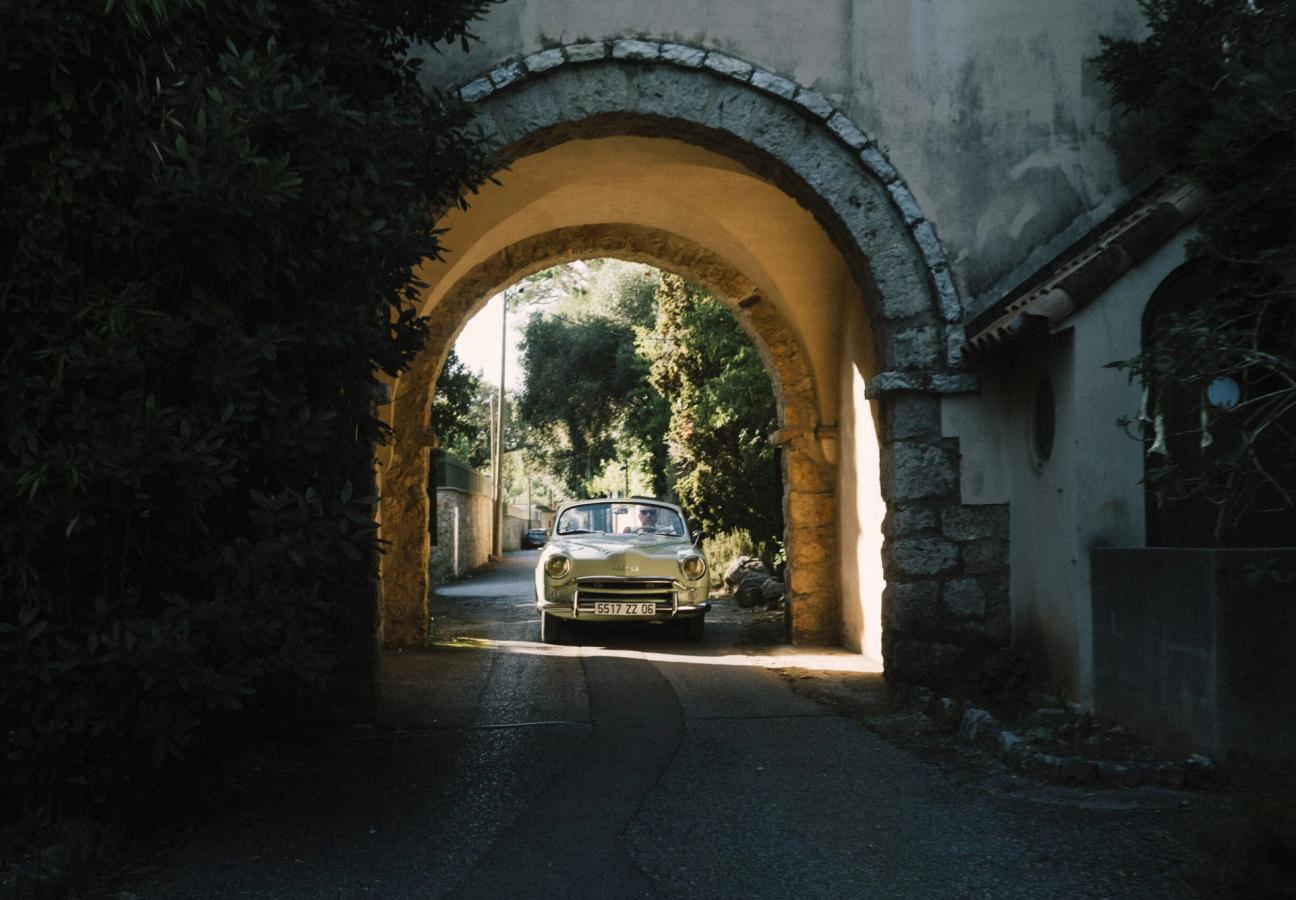
Pigozzi’s own life has been anything but formulaic. He was born in 1952 in Paris, France, the only son to Henri Théodore Pigozzi, a formidable entrepreneur who set up the SIMCA automobile company in the 1930s. “My childhood was not fun at all,” he says, “My father died when I was 12, and I was lost.” With some pride, a little later on, Pigozzi shows us an iPad mounted on the wall of the living room at Villa Dorane, loaded up to loop skittering black and white footage of the young family playing by the pool at some point in the early 1960s. But for now he skips past the distant stuff — the sudden heart attack his father suffered, and an adolescence marred by dank Jesuit boarding schools — and moves on to Harvard. “Which was where I really started having fun,” Pigozzi says.
The circumstances of the young man’s entrance to the Ivy League bastion are classic Pigozzi. “I was dyslexic, and in America there’s something called SATs. All the kids go to crammers and things, but I had no idea how to do them. So I got terrible results.” A little while later, dressed in his first suit, Pigozzi found himself in the offices of the Irving Bank Trust in Paris. “The interviewer asked me where I was from. I said: ‘I’m from Torino in Italy.’ He said: ‘Okay, I’m going to ask you two questions. And if you get them right you’re going to get into Harvard.’ He said: what’s the best restaurant in Torino? I said: ‘Il Gatto Nero.’ He said: when’s the season for white truffles? I said: ‘October-November.’ He said: ‘You will go to Harvard.’” And so he did. (On arrival at the halls of residence, however, Pigozzi couldn’t find his name anywhere on the list of incoming freshmen. It soon became clear that the administrators had assumed he was a Miss Jean Pigozzi, and had consigned him to Radcliffe Hall, along with 300 female students — a challenge too far, perhaps, even for the great Pigozzi.) It was at Harvard, and during his frequent weekend jaunts down to New York, that the young man began taking photographs.
“I started really when I was 9 or 10,” Pigozzi explains. “And my father gave me a very, very complicated old Leica. But when he passed away I got a Leica M3, which I started to use a lot.” Pigozzi would document his daily toings and froings like a hoarder-savant — a whirring, clicking, flickering presence on campus and off it, sometimes taking hundreds of photos in a single day. “I was interested in recording my life. But being dyslexic my handwriting is so bad I can’t read what I write. So I take photographs. And now with digital photographs it gives you the date, the time, and even the location, if you want. So my life is complete. It’s a diary.”
“The reason I invented the selfie is because I have very long arms..."
Like all great diaries, Pigozzi’s is not so much about its author as it is about everyone else. Elton John — a friend, of course — once dubbed Pigozzi an “upscale Weegee”: a reference to the ambulance-chasing hack snapper of 1940s and 1950s New York, whose crime-scene images held a lurid, compulsive draw. Here’s a Gagosian Gallery entry from Pigozzi’s 2010 exhibition, ‘Jonny STOP!’. The show, it says, is “a visual journal of his friends and social calendar,” which embraces “the company of the rich and famous rather than stalking celebrities with a telephoto lens to reveal their secrets.” Pigozzi, it concludes, is at once “insider and outsider”— but I’m not sure that’s quite right. The reason Pigozzi’s pictures are revealing and charming is that he is always an insider — just one without the in-group/out-group status anxiety of our petit bourgeois lives. If you don’t see the boundaries, it’s no trouble to waltz across them. Hence, perhaps, why he was able to conceive of the selfie at some point in the late 1970s — long before the advent of marketable vanity, or front-facing smartphone cameras, or Ellen Degeneres’s saccharine Oscar’s publicity stunt.
“The reason I invented the selfie is because I have very long arms,” he explains. (Pigozzi is 6ft 4, by the way, but always feels more). “And I used to use a Leica with a 35mm and a flash, so I could take the photos. No-one had done that before,” he says. “But the problem was, the flash would take more than 10 seconds to recycle. So I had to get it right the first time. And I missed a few.” He caught more. Where other young men might ask for autographs on the streets and dancefloors of Manhattan, Pigozzi would simply sidle up, press his face against his target, and hit the shutter. The results are honest, unexpected, and often quite sweet. Pigozzi in a cosy sandwich between Gerry Hall and Mick Jagger. Pigozzi with a rubber-faced, shovel-jawed Arnold Scwarzenegger. Pigozzi next door to an ebullient, shrieking Imam. Pigozzi with John Belushi, looking for all money like the brother he never had. And always with a sort of baby-faced insouciance and winning familiarity — not a fan, or a paparazzo, but an equal and a pal.
After Harvard, Pigozzi went to work for his uncle. “I made Supermarket carts. So I know more about them than you can imagine. I know everything. And there has been very, very little progress for the last 50 years, let me tell you.” But it was while working for a French film company in Los Angeles that he got his most formative education. Sitting by the pool at the Beverly Hills Hotel one afternoon, the young graduate bumped into Armut Erdogan, the founder of Atlantic Records. “A wonderful man. He gave me the three most important rules. Never go into the office before 12. Work should be fun. And women like to have sex. So those are my rules in life,” Pigozzi says. “It was around 1975, and from that day on my life was different.”
I ask Pigozzi what he says he does, when he bumps into people who don’t happen to know who he is. “Well, I try to do as many things as possible so I don’t think about death, basically,” he says.“I take photographs. I make books. I collect contemporary African art. I collect Japanese art. And I invest in startups.”
Pigozzi started early in the money game, nimbly deploying the inheritance that landed in his account in 1973, at the age of 21. “My father left me some money, and it was managed by traditional, stupid bankers,” he explains. “I remember when I went to visit, they had done all the accounts alphabetically — It was ridiculous. So I did a bit of homework, and I had a lawyer in New York who said you should meet this guy called George Soros. So I went to see George Soros. And he was running a fund with $170 million. I said: ‘I’d like to give you 220 thousand dollars.’ He said: ‘is that a lot for you?’ I said yes. He said: ‘you know I could lose it all.’ But I trusted him.” This was the early days of the Manhattan hedge fund boom: a power-suited wild frontier manned by Paul Tudor Jones, Stevie Cohen, Bruce Kovner, Leon Levy, Ben Rosen et al. Pigozzi invested with them all — the Zelig of asset management.
“Some of them were very very clever,” Pigozzi says. “Some of them were not. One guy — James Simons — had a completely computerised hedge fund. He started at MIT, and then was a code-breaker for the navy. But he realised there was no money in it. So he convinced his friend from Colombia to buy two vespas, and they drove from Boston to Colombia, and the father of the guy gave him a million dollars, and he started the most successful fund,” he says. “But to invest with him was incredibly difficult. I killed some little old ladies, and did some horrible things to get in there. He was a legend.” Pigozzi saw particular success in the shiny new tech stocks of the 1980s, and his plump fortune swelled.
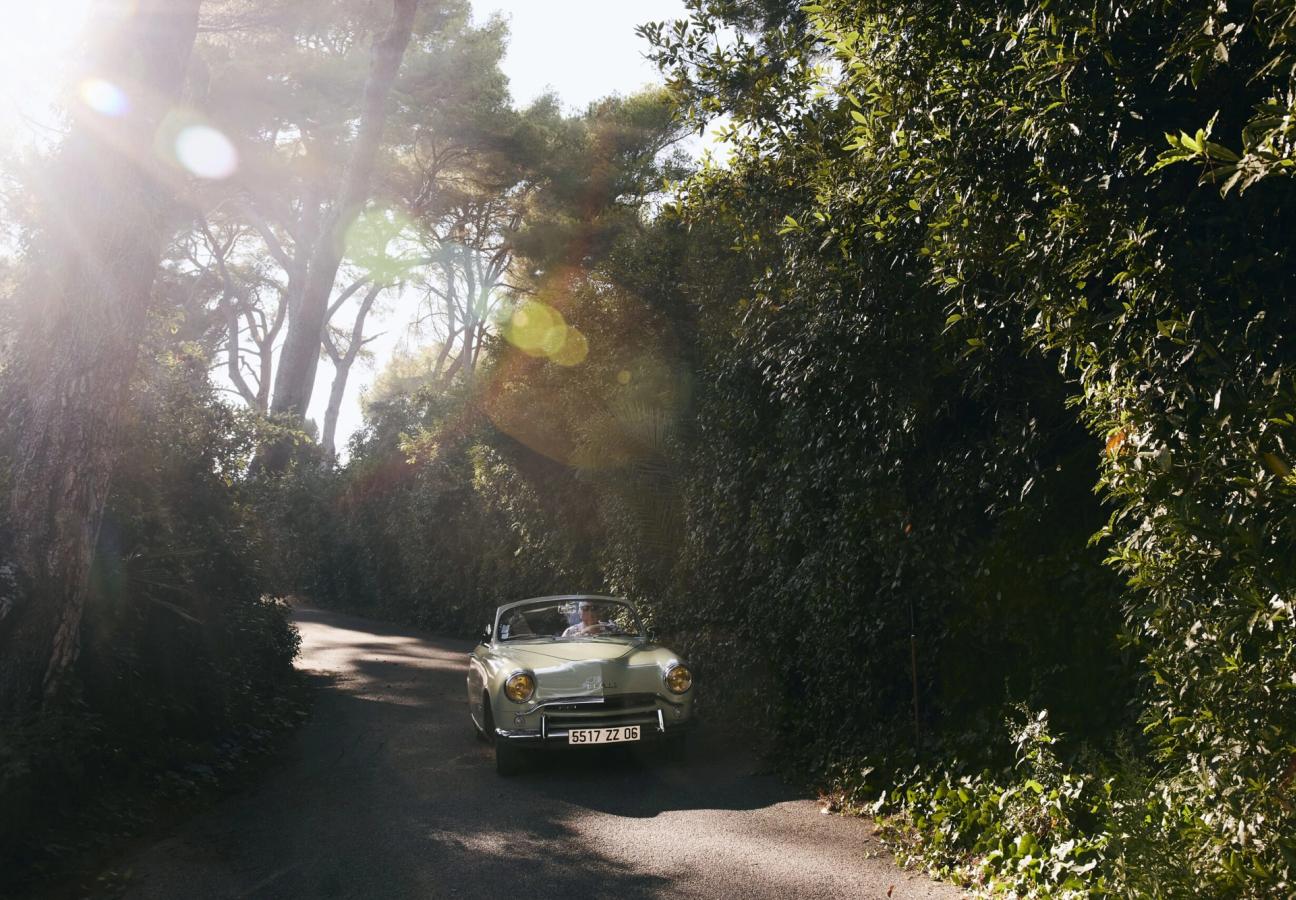
“But basically this hedge fund thing is boring,” he says, “It’s moving numbers from one place to another. I have nothing to do with them — I only have one hedge fund now. But the real thing I’m interested in is VC. [It creates] something, and there’s a purpose.”
“Last month, I listened to something called Y Combinator, where people can talk for one minute and introduce their company,” Pigozzi says. “I listened to 277 pitches, and I decided to speak to 50 companies, and I made 11 investments. That’s interesting to me,” Not, of course, that there is always strength in numbers. “Sometimes it works, sometimes it doesn’t. I’ve been to many high tech funerals, and invested in many companies that have crashed to zero. I have a few baseball caps with the name of a company [I once backed], and I think: ‘oh that baseball cap cost me $100,000’”, he smiles. “Once you’ve invested, then you start praying. Because [after that] there’s not much you can do.”
"I try to do as many things as possible, so I don't think about death..."
At some point, Pigozzi crossed orbits with Steve Jobs. “I knew him very well,” Pigozzi says. “He was an incredible guy. Super focused — the only person I have met on his level since is Elon Musk. And I’ve met a lot of people. Apple never did focus groups. Jobs didn’t invent — but he had a way of taking something and making it friendly, good looking, well-made. It was a really a lesson.”
What was he like to talk to? “There was no small talk or anything. One day I asked him: what do you do all day? He said that half of his day he spends interviewing people. And out of those people he interviewed, there’s only one person who will last more than six months. The other half of the worked on new products. But he said if you don’t have a good team around you, what can you do?”
“But these people are different,” Pigozzi continues. “One day I was having dinner with Elon Musk, and he wasn’t really listening to me. I said: ‘what are you thinking about?’ He said: ‘I was just thinking about how to make flying cars, and I might just have worked out how to do it. So those are the kind of people — they’re on a different level. Uber smart people who are doing things. These people roll up their sleeves.”
Pigozzi has a sniper’s eye for the genuine article. (“There’s nothing good about getting old,” he says. “Zero. Nothing. Except for the fact that your bullshit metre is much, much better. I’ve heard every lie in the world, and I’ve said a few too, myself,” he explains.) Not that there haven’t been some missed opportunities. “In 1985 I was at a high tech conference in San Francisco,” Pigozzi says. “There were perhaps 15 people in the room. There was a guy there, and he said: ‘two years ago I packed up my wife and two dogs and moved to New York to Seattle, and we’re going to sell books.’ I thought: look at this fucking idiot. Doesn’t he know what Barnes and Noble is? I didn’t invest. I thought it was stupid.” That idiot, of course, was Jeff Bezos, at the time of writing the richest man in the history of the world.
“I bought a Basquiat at his first show, for $1250 dollars,” Pigozzi says. “Three months later he asked me to come to the studio and buy a piece off him for $600. I said: you must be kidding. I’m not going to buy this piece of shit,” he waggles his finger. “I saw that exact piece three years ago in a gallery for $35million. So I made a huge amount of mistakes. But you can’t cry about it.”
Does he have any other regrets? “I have two big regrets in my life. One: I would have liked to be a great film director — but a great one, like Fellini or Kubrick or something,” he says. “But I’m not good at stories, because I’m dyslexic so I’m not good with scripts or books.
“The second thing I regret is not having children. I absolutely do not regret never being married. Zero regret. But not having children… and now they could have been 35: that would have been interesting. So that’s a big regret in my life.”
Pigozzi will turn 70 next year. (“I don’t think about it. I think I’m 45 years old,: he says. “I think they made a mistake on the passport.”) Normally I might ask someone on that threshold if they’ll ever retire — but here it’s a waste of good transcript. What does Pigozzi do for a living, anyway? The living seems to be most of it. And retiring from life is something of a long term solution.
“The interesting thing about these venture capital things,” he says, “is that usually they take between five and seven years to flourish. I’ll be 70 in a couple of months. If I was a normal person, I’d stop investing — as who knows how long I’m going to live for.” Pigozzi, of course, is not a normal person.
“My mother had a very old secretary, and when she was 70 she decided she was going to learn English. I said: ‘why does she bother? She’s going to die soon.’ And I understand now. It keeps you going.
“My rule is to be curious. Learning, learning, learning. You have to be curious all the time. When I go to bed at night — and I go to bed very late — and if I realise I didn’t learn anything that day, I think that’s terrible. It’s a wasted day. I have kind of a rule. If I do one good thing a day, that’s pretty good.”
"I have kind of a rule. If I do one good thing a day, that’s pretty good..."
The strategy appears to be working. Pigozzi is the youngest 69-year-old around, even among the surgically-prolonged Riviera set. Just before we leave, after he has walked off across the lawn with his two dogs, Charles and Saatchi, a friend of his who’s staying at the house comes up and says hello. She seems keen to impress upon us the essence of our host: that he is wise and seasoned, but always childishly curious and fresh-eyed. (It is one of Pigozzi’s many gentle contradictions: despite his large appetites, he is a lifelong teetotaller.) He has friends, she says, who are 21, and friends who are 91, and his house, on reflection, is filled not so much with spoils but with toys: the electric drum kit he is playing when we first arrive; the cameras and electronics scattered over his various desks; the nine euro Decathlon sunglasses he proudly shows off to us; the vintage cars he uses to romp around the peninsula, one of which is a doting restoration of his father’s 1950s SIMCA. There is an almost boyish, sweet shyness to his eyes when we meet, and his wardrobe is a colourful, adolescent hodge-podge of striped polo shirts and bright baseball caps. Earlier, by the pool, he had explained to us that some people settle and ossify at 25, some at 35, some at 45, and so on. The success and appeal of Pigozzi is that he never did.
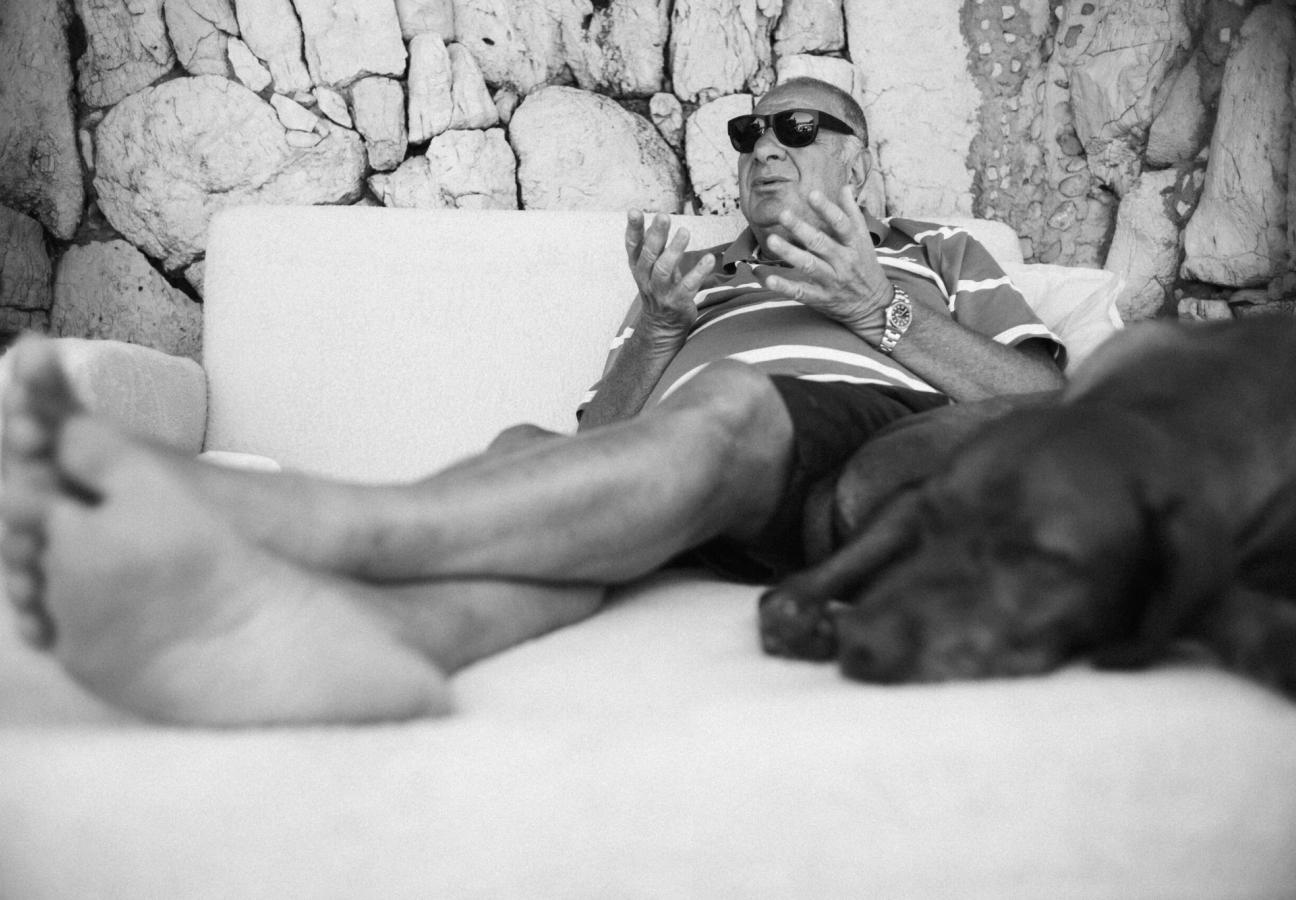
What has he learned over the years? “People have five meetings a day, and are so busy,” he says. “But I think if you have one amazing meeting a month, that’s incredible. We have this thing about running and running and running. In places like London and New York, you have to do 50 things a day. And for what? At the end of the day, why?
“So with age, you start learning to really select. I hate the word ‘curating’,” he says. “But as you get older, you learn how to curate your time.” Our host, the arch collector, has arranged his better than most. Youth is wasted on the young. But it is well spent on Jean Pigozzi.
Read next: Lion-whisperer Tony Fitzjohn shares his memories of Kenya, bandits and wild beasts
